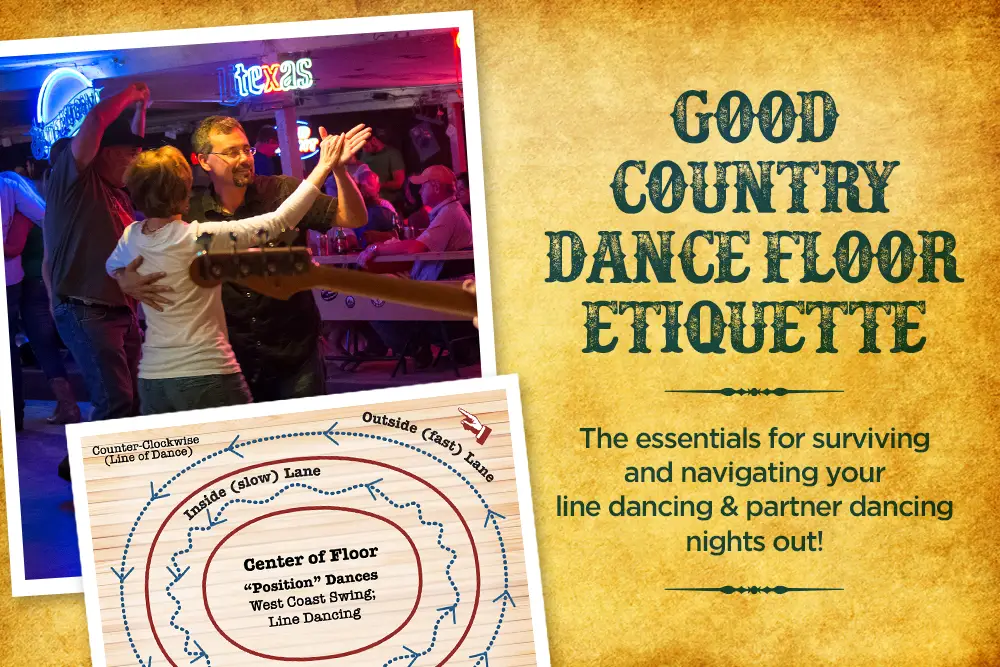
From the earliest days that I really started dancing, I became aware quickly there was an etiquette to follow for the dance floor.
Now after years of dancing, I have a fairly good idea of what good dance floor etiquette is and what it is not. This article is intended to give a good round-up of the important things to keep in mind while having a nice fun night out at your local dance hall or saloon.
There are many “need-to-knows” and sometimes people just don’t tell you the stuff you really need to know! As I compiled these, I didn’t just rely on my own experience but did a little research. Interwoven throughout are some thoughts from Aria Nosratinia, who seems to have this topic covered very well. See the links below to his articles. In general, he says “the dance hall is a social environment where the delicate activity of dancing should be without unpleasantness.” I agree wholeheartedly.
Here are the points of etiquette I’ve corralled together. Use this as a table of contents, and click on the sections that pique your interest!
Kindness & Acceptance
Good Dance Floor Etiquette for Partner Dancing
Partner Dancing: Understand the Line Of Dance for Progressive Dancing
Partner Dancing: Be Aware of the Dance Floor “Lanes of Traffic” while Partner Dancing
Partner Dancing: Asking Someone to Dance – the Dos and Don’ts!
Partner Dancing: The Dance
Partner Dancing: Understand How Romance and the Dance Floor Work and Don’t Work
Good Dance Floor Etiquette for Line Dancing
Line Dancing: Be a Nice Line Dancer!
Line Dancing: Don’t Walk Through the Lines to Find a Good Spot If the Dance Is in Progress
Line Dancing: Help Others by Holding Back Your Styling Sometimes
Miscellaneous Points of Etiquette for the Dance Floor
Don’t bring drinks out onto the dance floor.
Proper Use of the Dance Floor When “Splitting the Floor”
Taking Videos & Photos of People Dancing.
Kindness & Acceptance
So, the first and foremost part of dance floor etiquette needs to be all about kindness and acceptance.
If you think about it, the dance floor is a unique space. Where else do people come who don’t even know each other and spend time dancing around each other?
Going out on the dance floor can make you feel very vulnerable. It is easy to be very self-conscious about how you look and how good or bad of a dancer you are. Because of that, it is especially important if you are a veteran and a great dancer to never even hint that a new person looks bad or silly, but rather do everything you can to make them feel welcome and part of the group.
I know when I started dancing, I felt a little embarrassed and very intimidated by the veteran dancers all around me. Honestly, I still do sometimes! But for the most part, people were so kind and just kept saying “We all started somewhere!”
So, let’s all just try to mix in some love and kindness when out dancing. Applying the Golden Rule is always a great thing and ends up feeling really great for everyone.
Good Dance Floor Etiquette for Partner Dancing
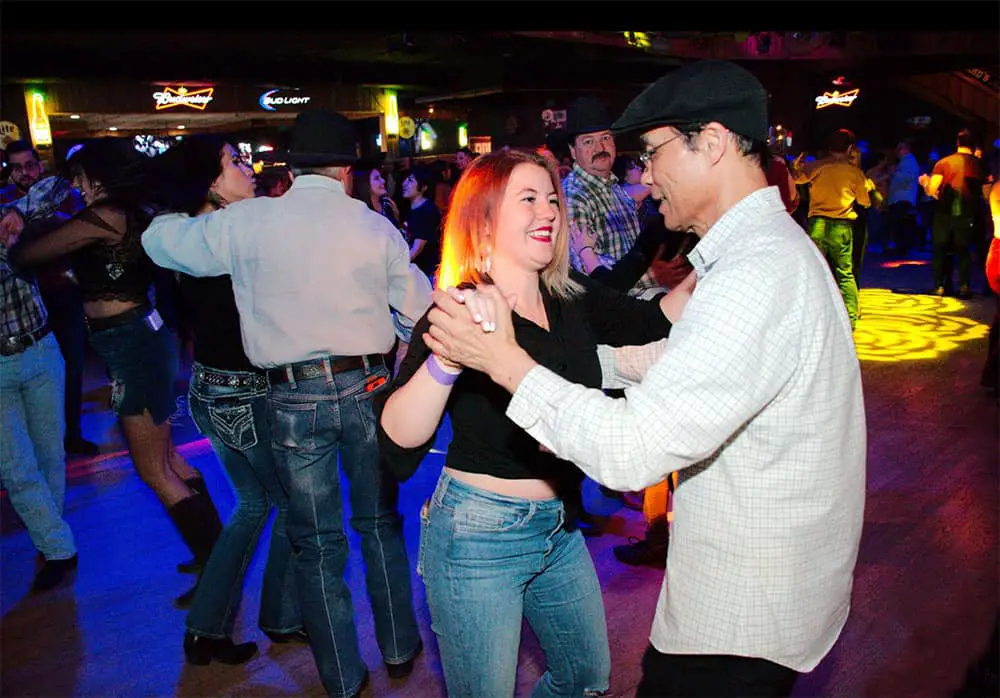
In a social dance setting, and as is the focus of this blog; the country dance saloon setting, there are really two main aspects: partner dancing and line dancing. For most of this article, I want to break down dance floor etiquette into these two areas. Beginning with partner dancing. In general, partner dancing can be a little more difficult to navigate when it comes to etiquette since it involves socializing and connection between two people.
Understand the Line Of Dance for Progressive Dancing
First, a little technical one to start with! Line of dance, or direction of movement on a dance floor. All partner dancing progresses in a counter-clockwise direction. This is the very first thing to know really about getting on the dance floor to start. Whether it be Two Stepping, one of the Cha Chas, or other partner dances, they all travel counterclockwise. See the graphic below for a visual that shows this.
Be Aware of the Dance Floor “Lanes of Traffic” while Partner Dancing
The outside lane on the dance floor is the fastest and should be reserved for seasoned dancers. If you are more of a beginner stay closer to the center of the dance floor. However, the very middle of the dance floor should be the place for people to try something more stationary and/or advanced.
The dance floor can be a very crowded and intimidating place sometimes. It’s like a race track! It may take some time to get used to how it goes at your local bar. But in general, faster dancers to the outside, slower a little more near the middle.
At times, I have seen really good dancers sort of just stop in the fast outer lane to do their fancy “tricks.” This isn’t good! It just causes disruption in the flow and could get someone hurt. No dancer pile-ups, please! And accomplished dancers should know this and be considerate of others around them!
If advanced dancers need to dance in one spot they should move toward the very middle for more complicated and stationary patterns.
But it’s tricky cause slower, newer dancers need to find a lane in between somewhere! I will sometimes use the very middle to bring a new dancer out onto the floor to teach them the basics, but as quickly as possible move into the “slow lane.”
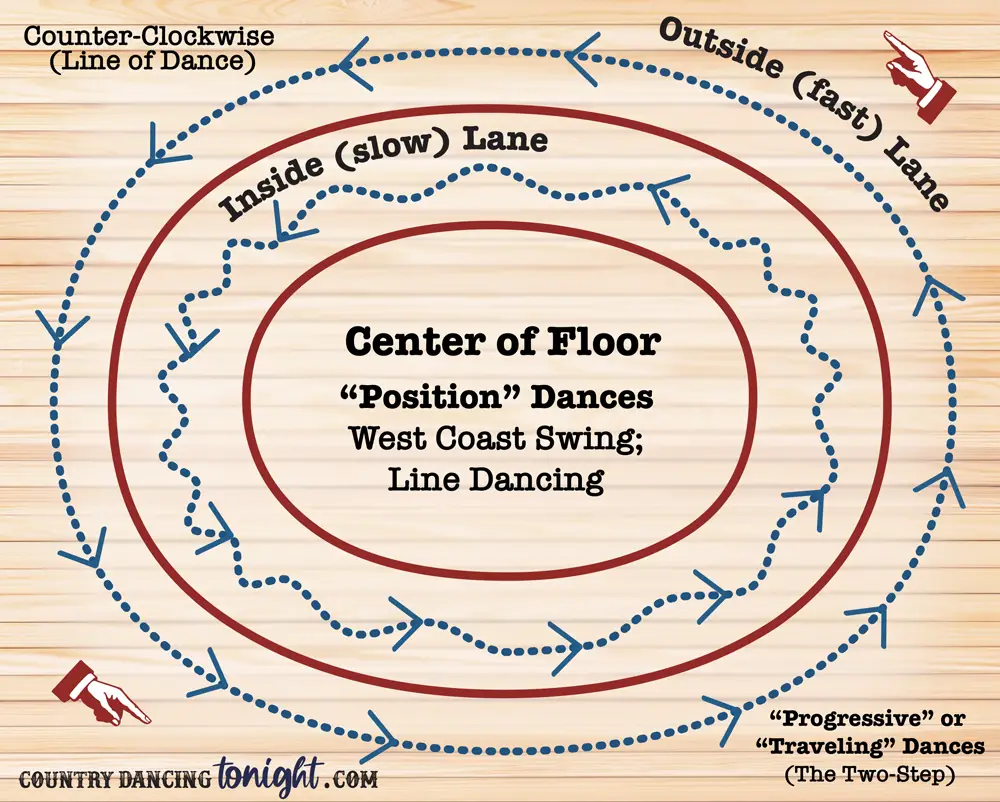
I often feel that a big skill in Two Stepping is just avoiding collisions on the dance floor! To always be looking out, speeding up, slowing down, splitting a narrow gap quickly… whatever is needed to smoothly move around the other dancers on the dance floor without contact.
But if you do crash into someone, just politely apologize and keep going this is common and everyone should understand we will bump into each other at times. And, as Paul McClure says just assume it’s your fault and take the blame.
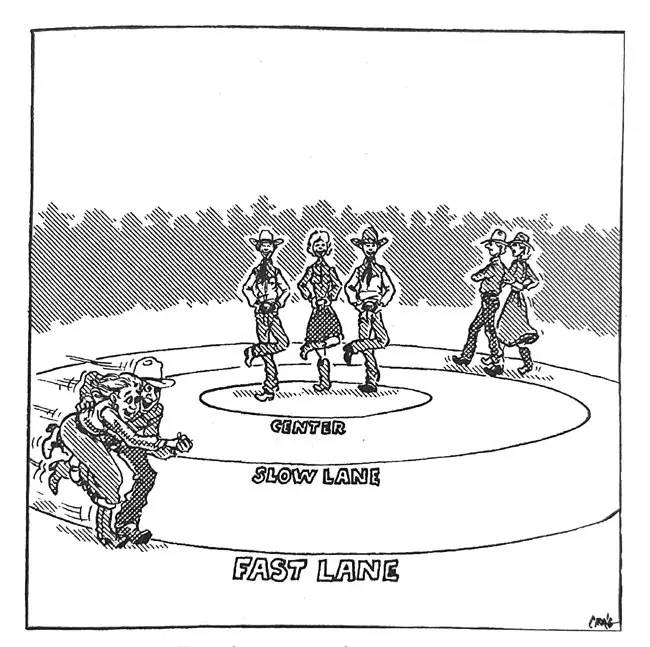
Asking Someone to Dance – the Dos and Don’ts!
Ah, the timeless tradition of the men asking the women to dance! This practice lives on every weekend at country dance halls around the world. Back in the ’90s, Paul McClure tried to get the word out that women can also ask the men to dance!
I like that and I agree with it! There’s really no reason in the social dance setting why the women shouldn’t feel they can’t approach the men for a dance. I wish somehow, we’d see more of that.
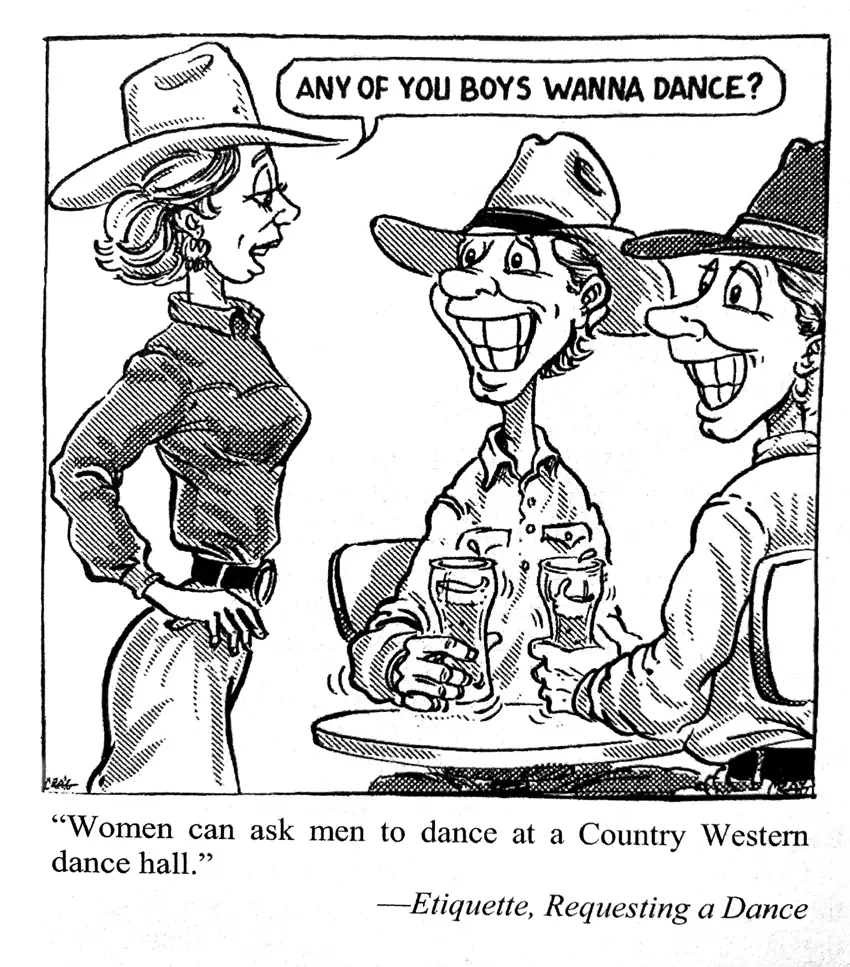
But, since the guys are still the primary askers, I think that’s what I want to talk about!
But, back to Paul McClure for a moment… If you haven’t read or heard about Paul McClure’s books about country dance written back in the ’90s during the country dance heyday, for sure check those out and give them a read! They are great books and talk about country dancing with the right tone. Mainly one of frivolity! I like that, cause really country dancing isn’t something to take too seriously. It’s a great fun social activity, that, while also pursued professionally and very seriously by some, is something we all just dabble in for a few hours on a Friday or Saturday night for fun.
But back to the men asking the women to dance! I think the main thing about this, from what I see is that there seems to be a general consensus that the women should nearly always say “Yes!” And, I get it! If a woman has come to the country bar where there’s dancing, it’s most likely cause she is interested in dancing!
But, in actuality on any given evening there are going to be those new women on the scene who either have never danced or are just learning. And with that there may be some hesitation. So, there are going to be women that really don’t want to dance!
And so the drama begins! What I think is lacking sometimes and all we cowboys need to be cognizant of is how to approach a woman and especially how to graciously receive the “No, thank you.” I think a lot of us guys are guilty of this, myself included. There’s something in our pride and ego that convinces us we need to hear “yes” every time and at all costs.
Sometimes men basically are unwilling to take “no” for an answer. At first, it’s all fun and playful, but after 2, 3, and 4 “Nos!” we’re somehow still there badgering and trying to close the deal.
And if she caves under the pressure then, is that really what we want? Basically, the cowboy bullied her into going out on the dance floor when she really wasn’t comfortable. Not a good way to start!
But wait, here’s another way we can go wrong: what if she’s willing but makes some requests, like “please take it easy,” or “I’ll dance, but no turns, please, I’m not quite there yet.” And then, the man ignores this, telling her she’s in good hands with him and she can do it! And then he proceeds to force her to dance above and beyond her ability or desire.
This all just comes down to simple respect and being a good listener and gracious ambassador for the dance floor. If she says “No!” she means no, if she says “No spins!” she means, no spins! One point Paul McClure makes about this is to dance down to the level of your partner, don’t force them up to your level. In his “Eight More Dance Commandments,” he says:
Thou shalt dance at thy partner’s level of ability.
And, of course, this goes for both leader and follower!
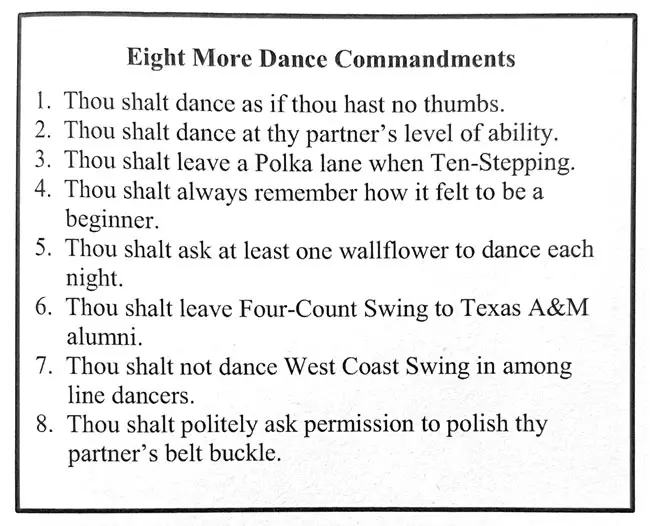
I think our goal as more seasoned and experienced dancers should be to do all we can to make newcomers (whether they be men or women) have a fun night! That they actually enjoy themselves and feel comfortable. If all they can do is dip their toe in tonight, that should be okay and acceptable and even celebrated. And if that is our attitude, the person is probably more likely to want to come back and maybe take the next step!
So, next time fellas when that new lady grimaces and says “I’m sorry, I’m not up to it right now,” that’s your cue to say “Oh, no worries, maybe next time, I’m glad you came!” And then move on, more than likely there’s an eager partner two bar stools down, anxiously waiting for the ask!
The Dance
But, moving on! She, or he says “yes!” and you are on your way…. For this part I do want to just borrow from Paul McClure’s book Country Dance Etiquette. I love his outlook and I think he has it right about the kind of attitude to have at the dance hall:
The cowboy’s goal is to see that his partner is safe, comfortable, and having a good time. He does not hot dog, lead harshly, give instructions while dancing, repeat a broken move more than once, or pass judgment on his partner’s dancing ability.
Ladies treat their partners with the same respect by not coaching, back-leading, or requesting particular moves. Remember: cowboys do not make mistakes on the dance floor, they do “variations.” When you encounter a cowboy who dazzles you with variations, smile and remind yourself the experience will deepen your appreciation for other dance partners.
Low expectations for your partner make satisfaction more attainable. A good dancer with an unskilled partner doesn’t grouse but instead relishes the opportunity to work on fundamentals including frame, floorecraft, footwork, timing, smoothness, position, body alignment, rate of progression, clarity of leads, and responsiveness to the partner. – Paul McClure
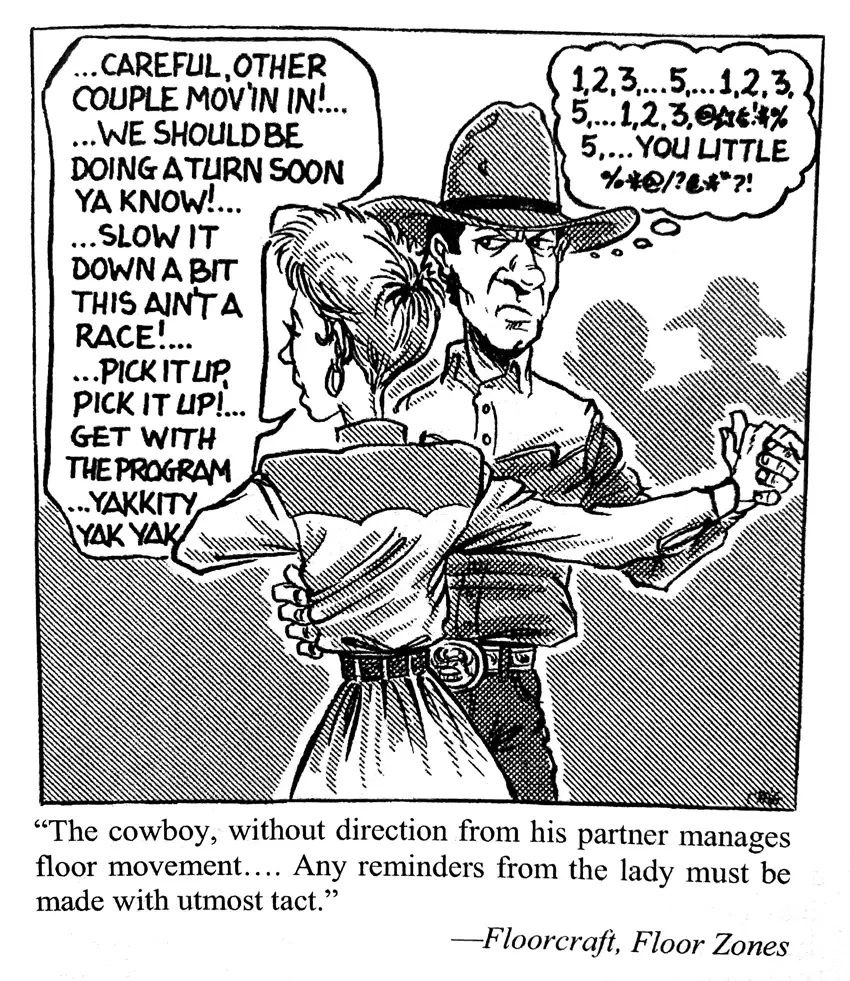
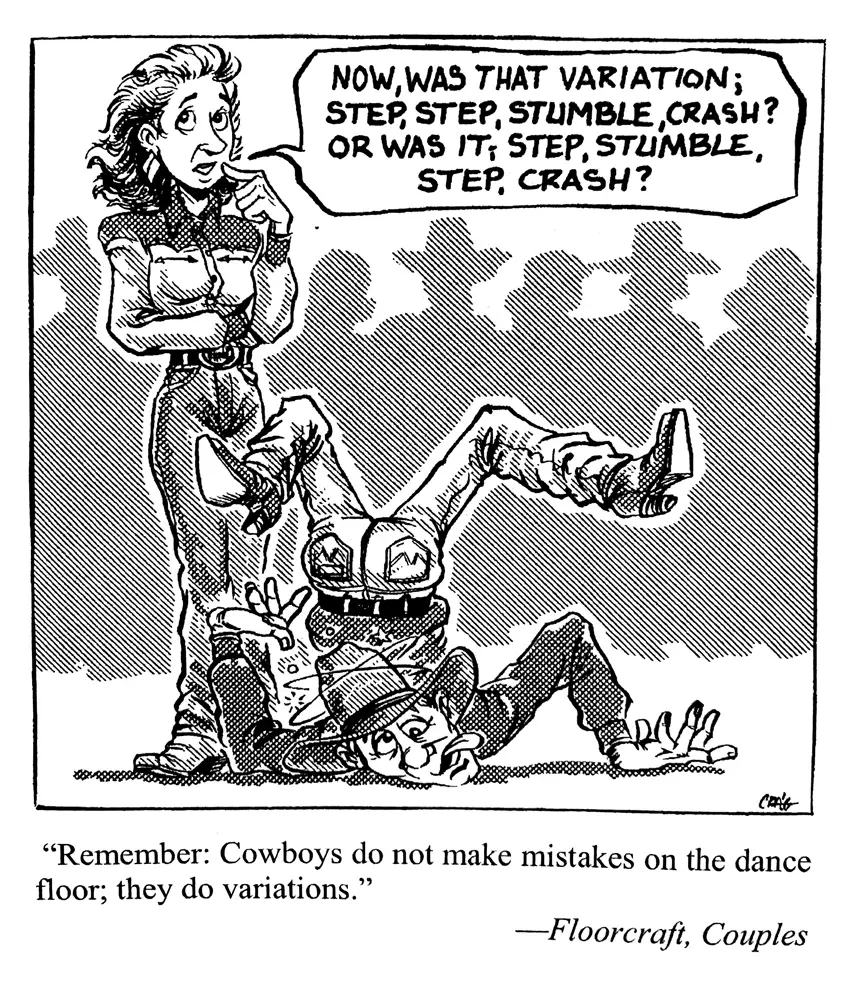
As someone who still has a lot to learn and room to grow as a dancer, I have done more than my share of “variations!” When these occur, I do appreciate the partner who just smiles, laughs, and does her best to adjust to the chaos, until I get back on track.
Understand the Place Romance has in the Country Bar & Dance Hall
And, since we’re talking men & women, let’s move on to a different level that this can get to in the social dance environment, namely getting the wrong idea about intentions and getting hurt feelings!
This really highlights how a social dance floor is a unique place that exposes vulnerability and is very fraught with pitfalls to avoid!
But, I’ll start with a caveat again! Yes, the country bar and dance hall certainly is a place where people meet and may even fall in love! Many a couple have found each other because of their love for country dancing! But, for the most part, there will mainly be friendships and a lot of guys and gals dancing together as friends, which sometimes can be tricky!
Dancing together as a couple is just intrinsically a romantic activity! I think this is widely known, but the challenge remains how to enjoy the little bit of romanticness of dancing with the opposite gender and then just leave it there with no expectations for more.
I think for the most part it works cause we just all know this. Just don’t forget and don’t misinterpret someone’s interest in dancing with you as something more. Assume nothing more until they actually do make further intentions known. Then, of course, it’s a whole new ball game! This is basically my quick summation and gleanings from Aria Nosratinia’s thoughts on it, for his much deeper dive go here.
Good Dance Floor Etiquette for Line Dancing

Be a Nice Line Dancer!
For the line dance aspect of good dance floor etiquette, I would really push the whole kindness thing more. This is a good place to practice acceptance of everyone and also to be positive and encouraging. And, partially for the sake of the line dance instructor, be excited and enthusiastic, and responsive! This attitude will be contagious! One thing great about the line dance and country dance community is that generally, this is very much the case. But, it’s always a good reminder of how important this is for a local community of dancers. Be kind!
Don’t Walk Through the Lines to Find a Good Spot If the Dance Is in Progress
If a line dance is in progress don’t walk through the lines to find a spot, but join on the edge. This is actually a new one to me! I found it in some research and thought I’d add it. I think it is just for safety I guess. You wouldn’t want someone running into you because you are just randomly in their space. So, when joining a line dance late, try to join on the side. And it also goes that you should try not to leave the dance floor from the middle while it’s in progress if possible.
Help Others by Holding Back Your Styling Sometimes
I don’t want to make too big a deal of this! Adding styling to line dance is a great thing and as you progress of course it is encouraged! Have fun and make the dance your own! Add the spins and extra body choreography to your heart’s content. But, also I think there are times when as you are just aware of your setting you may see people struggling to get a new dance, and it’s time to hold back a bit.
This would mostly pertain mainly to a new lesson that has just been given. If you see someone struggling and they are near you, and especially if they are watching you dance, don’t use that moment to show off and do extra spins! But rather see how textbook and perfect you can dance the choreography to perhaps help them get it faster! They just might come up to you after and thank you!
Miscellaneous Points of Etiquette for the Dance Floor
Don’t bring drinks out onto the dance floor.
This is a widely known one and people are very passionate about it! (I dare you to bring this up in your dancing Facebook groups!) But as far as the rules of a dance hall or saloon go they can vary. Some places make it clear, while others are more laid back and don’t really care. But just use common sense and probably most times leave your drinks behind while you dance! I saw someone dancing with a bottle once and actually thought it wasn’t a big deal–there was no spillage!
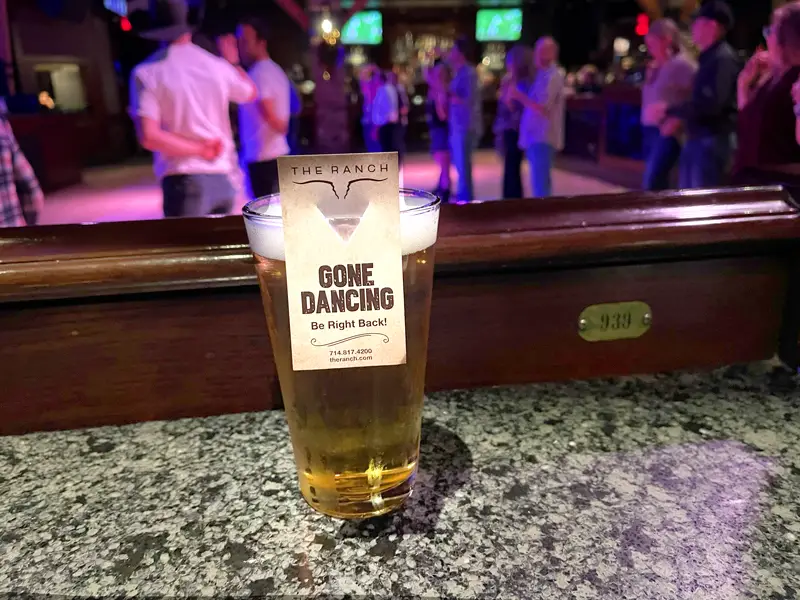
But here’s a caution! Please ladies, be careful not to leave your drink unattended because you are trying to follow this rule. Maybe just wait to get a drink until you want to sit and rest for a while. Unfortunately there are some brazen bad actors out there who are up to no good and might tamper with your drink! Better to be safe than sorry!
Proper Use of the Dance Floor When “Splitting the Floor”
For many dance clubs, it is common to have line dancing and partner dancing sharing the floor! The line dancing occurs in the middle and the partner dancing will progress in a counter-clockwise direction in the outside lane. The point of etiquette here is that the partner dancers have the right of way! The line dancers have the responsibility to not drift into the outer lane, so take smaller steps if need be!
Taking Videos & Photos of People Dancing.
This is a tricky one! In this digital age where we all have high-res cameras built right into our phones, we are constantly capturing moments of our lives like never before. And in the dance scene, it is often tempting to take a video of the dance floor, because, first of all, it’s a fun and exciting scene and moment you want to record and maybe share. But also, if you’re trying to learn a line dance it’s nice to maybe record people doing it so you can review it later.
I think for the most part in this nowadays, it’s acceptable to do this, however, I have once been approached and asked to stop. A young lady saw me videotaping and she felt uncomfortable about being on someone’s phone who she didn’t know. Really this is totally understandable and all I could do is say, “No problem I’ll stop!” So, just be understanding and entreated if someone objects!
And in general, I just try not to record videos very much. There might be people who feel the same way. It just takes 30 seconds or a minute max to get a video of a line dance. So, if I want to capture it, I try to be discrete and quick. Also, if I’m in a new bar and no one knows me, I’m not going to want to all of sudden be there recording a lot of videos. There’s an even bigger chance someone is going to wonder who I am and why I’m recording them! Although again, people generally are more and more used to this, and if dancing in the middle of an exciting dance floor may even expect to see an observer capturing that moment.
It’s just a matter of being aware of the room you’re in and using some common sense. Please comment below if you have thoughts on this. I think it’s a tricky one and may evolve over time. It does seem to be more and more acceptable in this world of mobile phones with cameras and everyone having a social media account that they want to post to.
In Conclusion
So, there you have it! My somewhat deep dive into Dance Floor Etiquette. Hopefully in true Emily Post fashion, I’ve created a true and accurate list of points of etiquette, but specifically as pertains to our country dancing together. But speaking of Emily Post, she does have some writing on dances, albeit a little outdated from us. One thing she does say though that I think is still in play: “Men who dance are always an asset, and the more the better.” This is true to this day! But for fun here’s her actual advice when it comes to “Balls & Dances” -check it out!
And as always, if I’ve got something here not quite right or if I’ve omitted a biggie, please leave a comment below or email me!
Want More?
Besides Aria Nosratinia’s articles on Dance Floor Etiquette, Paul McClure has written an entire book on the subject! Along with his other book The Pablo Stories. These are great reads and those who enjoy the country dance scene will be able to relate to many or all of the stories he tells and the dance floor etiquette concepts he lays out therein. Below are links to get these on Amazon (with both printings of Country Dance Etiquette available).
Sources:
Aria Nosratinia’s articles on Dance Floor Etiquette…
Elements of Dance Etiquette By Aria Nosratinia
Beyond Dance Etiquette By Aria Nosratinia
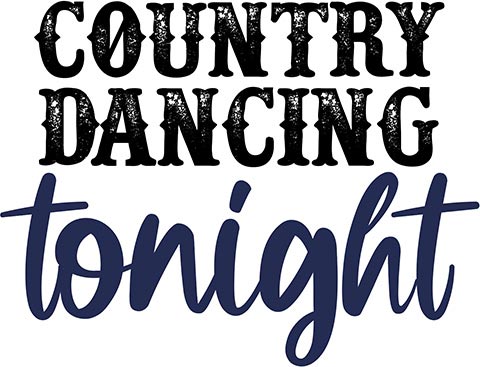



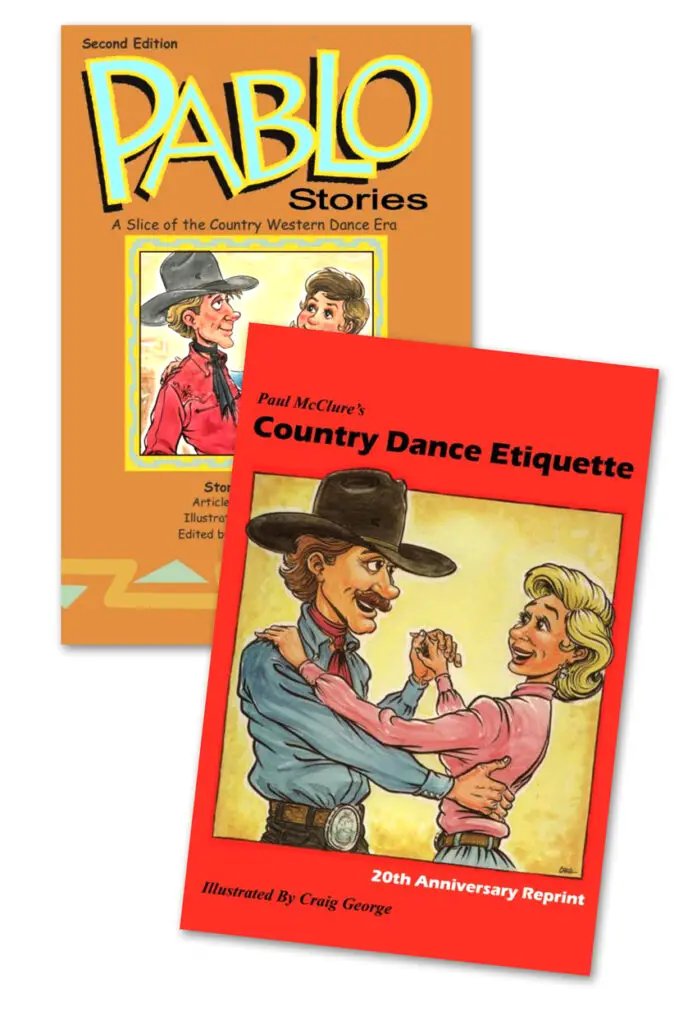
Thank you for such a wealth of useful and entertaining insights into the c/w dance world and social dancing in general.
I especially appreciate your inclusion of “Aria N’s dance etiquette”. The longer I dance, the more I realized how important it is to understand certain timeless social “rules” of dancing that don’t change. Thank you Brian
Thank you so much Jo Ann! I really enjoyed putting this one together! Yes, Aria Nosratinia’s two articles on the topic, as well as Paul McClure’s books to me, seem like the best resources for this topic. And, I think you’re right–there are timeless social “rules” of dancing that will probably always be in play.
Loved it! Thanks Brian for all the valuable information. It was a very interesting article. Being kind to the other dancers is so important and it isn’t just for when you are on the dance floor. Be kind when you are watching others dancing. Making comments about the way others dance is usually not kind. You don’t have to be a good dancer to go dancing. Just have fun and let others have fun.
Thank you Dori for your comment! And I agree, that is a good point about keeping your comments to yourself! Adia Nuno keeps saying that our dancing should be “All Out… As Is.” To go all out, but just be ourselves, without thought for how we’re different or not as good as someone else, etc. What certainly helps is if we are always accepting of each other just as is.